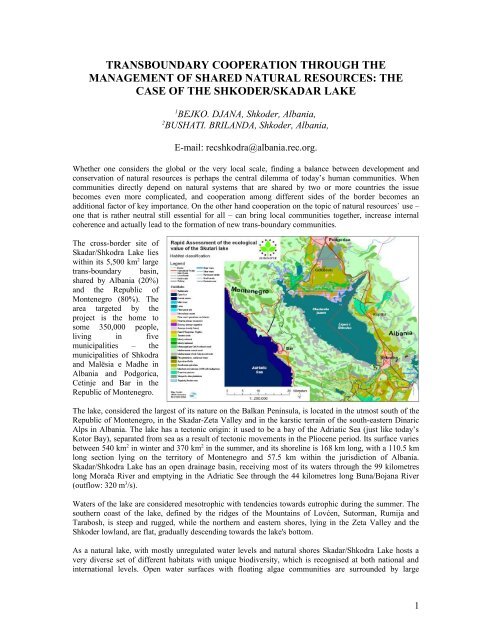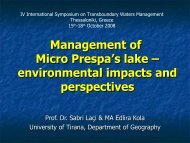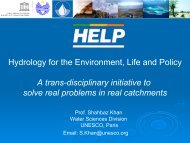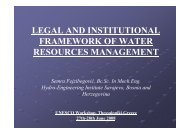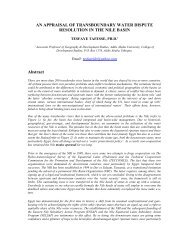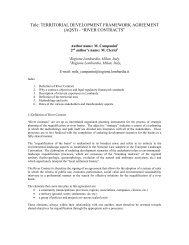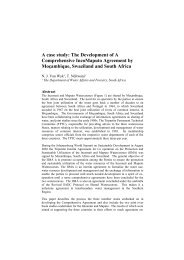transboundary cooperation through the management of ... - inweb
transboundary cooperation through the management of ... - inweb
transboundary cooperation through the management of ... - inweb
Create successful ePaper yourself
Turn your PDF publications into a flip-book with our unique Google optimized e-Paper software.
TRANSBOUNDARY COOPERATION THROUGH THE<br />
MANAGEMENT OF SHARED NATURAL RESOURCES: THE<br />
CASE OF THE SHKODER/SKADAR LAKE<br />
1<br />
BEJKO. DJANA, Shkoder, Albania,<br />
2<br />
BUSHATI. BRILANDA, Shkoder, Albania,<br />
E-mail: recshkodra@albania.rec.org.<br />
Whe<strong>the</strong>r one considers <strong>the</strong> global or <strong>the</strong> very local scale, finding a balance between development and<br />
conservation <strong>of</strong> natural resources is perhaps <strong>the</strong> central dilemma <strong>of</strong> today’s human communities. When<br />
communities directly depend on natural systems that are shared by two or more countries <strong>the</strong> issue<br />
becomes even more complicated, and <strong>cooperation</strong> among different sides <strong>of</strong> <strong>the</strong> border becomes an<br />
additional factor <strong>of</strong> key importance. On <strong>the</strong> o<strong>the</strong>r hand <strong>cooperation</strong> on <strong>the</strong> topic <strong>of</strong> natural resources` use –<br />
one that is ra<strong>the</strong>r neutral still essential for all – can bring local communities toge<strong>the</strong>r, increase internal<br />
coherence and actually lead to <strong>the</strong> formation <strong>of</strong> new trans-boundary communities.<br />
The cross-border site <strong>of</strong><br />
Skadar/Shkodra Lake lies<br />
within its 5,500 km 2 large<br />
trans-boundary basin,<br />
shared by Albania (20%)<br />
and <strong>the</strong> Republic <strong>of</strong><br />
Montenegro (80%). The<br />
area targeted by <strong>the</strong><br />
project is <strong>the</strong> home to<br />
some 350,000 people,<br />
living in five<br />
municipalities – <strong>the</strong><br />
municipalities <strong>of</strong> Shkodra<br />
and Malësia e Madhe in<br />
Albania and Podgorica,<br />
Cetinje and Bar in <strong>the</strong><br />
Republic <strong>of</strong> Montenegro.<br />
The lake, considered <strong>the</strong> largest <strong>of</strong> its nature on <strong>the</strong> Balkan Peninsula, is located in <strong>the</strong> utmost south <strong>of</strong> <strong>the</strong><br />
Republic <strong>of</strong> Montenegro, in <strong>the</strong> Skadar-Zeta Valley and in <strong>the</strong> karstic terrain <strong>of</strong> <strong>the</strong> south-eastern Dinaric<br />
Alps in Albania. The lake has a tectonic origin: it used to be a bay <strong>of</strong> <strong>the</strong> Adriatic Sea (just like today’s<br />
Kotor Bay), separated from sea as a result <strong>of</strong> tectonic movements in <strong>the</strong> Pliocene period. Its surface varies<br />
between 540 km 2 in winter and 370 km 2 in <strong>the</strong> summer, and its shoreline is 168 km long, with a 110.5 km<br />
long section lying on <strong>the</strong> territory <strong>of</strong> Montenegro and 57.5 km within <strong>the</strong> jurisdiction <strong>of</strong> Albania.<br />
Skadar/Shkodra Lake has an open drainage basin, receiving most <strong>of</strong> its waters <strong>through</strong> <strong>the</strong> 99 kilometres<br />
long Morača River and emptying in <strong>the</strong> Adriatic See <strong>through</strong> <strong>the</strong> 44 kilometres long Buna/Bojana River<br />
(outflow: 320 m 3 /s).<br />
Waters <strong>of</strong> <strong>the</strong> lake are considered mesotrophic with tendencies towards eutrophic during <strong>the</strong> summer. The<br />
sou<strong>the</strong>rn coast <strong>of</strong> <strong>the</strong> lake, defined by <strong>the</strong> ridges <strong>of</strong> <strong>the</strong> Mountains <strong>of</strong> Lovćen, Sutorman, Rumija and<br />
Tarabosh, is steep and rugged, while <strong>the</strong> nor<strong>the</strong>rn and eastern shores, lying in <strong>the</strong> Zeta Valley and <strong>the</strong><br />
Shkoder lowland, are flat, gradually descending towards <strong>the</strong> lake's bottom.<br />
As a natural lake, with mostly unregulated water levels and natural shores Skadar/Shkodra Lake hosts a<br />
very diverse set <strong>of</strong> different habitats with unique biodiversity, which is recognised at both national and<br />
international levels. Open water surfaces with floating algae communities are surrounded by large<br />
1
wetlands with rooted and floating Euhydrophytic vegetation <strong>of</strong> white water lily (Nymphea alba), yellow<br />
pond lily (Nuphar luteum) and water-chestnut (Trapa natans). Reed beds, flood forests with poplar and<br />
willow species, and periodically flooded tufted sedge (Carex elata) vegetation are also common in <strong>the</strong><br />
area. Driest parts <strong>of</strong> wetlands are overgrown with Skadar oak (Quercus robur scutarensis) and Caucasian<br />
ash (Fraxinus oxycarpa) forests, while <strong>the</strong> dry slopes <strong>of</strong> surrounding mountains are covered by submediterranean<br />
pseudo-maquis vegetation with Carpinus orientalis, Punica granatum, Paliurus spinachristi,<br />
Ficus carica, and o<strong>the</strong>rs.<br />
This large variety <strong>of</strong> habitats supports a rich assemblage <strong>of</strong> species: 726 vascular plants, with more <strong>the</strong>n 30<br />
rare species, more <strong>the</strong>n 50 fish species (15 <strong>of</strong> <strong>the</strong>m endemic to <strong>the</strong> water system), 15 amphibians, 30<br />
reptiles, 271 bird species (90% <strong>of</strong> <strong>the</strong>m migratory species <strong>of</strong> international conservation concern), and 57<br />
mammals.<br />
Corresponding to its natural richness, by today most <strong>of</strong> <strong>the</strong> lake and adjacent wetland areas are under<br />
<strong>of</strong>ficial nature conservation and are also recognised as wetlands <strong>of</strong> international importance under <strong>the</strong><br />
Ramsar convention. In 1983 a National Park has been established on <strong>the</strong> Montenegrin side <strong>of</strong> <strong>the</strong> lake, on<br />
an area <strong>of</strong> 40,000 hectares, while <strong>the</strong> Albanian side – some 23,027 hectares – received <strong>the</strong> status <strong>of</strong><br />
managed nature reserve in November 2005. The Ramsar diploma has been awarded to <strong>the</strong> lake in<br />
December 1995 for its Montenegrin side and in February 2006 for <strong>the</strong> newly established Albanian<br />
protected area.<br />
The Skadar/Shkodra Lake region is not only rich in natural values, but it also has a very long history with a<br />
lot <strong>of</strong> remnants visible even today. There are more <strong>the</strong>n 20 old monasteries and archaeological sites on <strong>the</strong><br />
Montenegrin side, while on <strong>the</strong> Albanian side Shkodra castle named “Rozafa”, with its more <strong>the</strong>n 2500<br />
years <strong>of</strong> history is <strong>the</strong> most significant historical value.<br />
Agriculture, fishing and tourism are <strong>the</strong> most relevant economic activities <strong>of</strong> <strong>the</strong> population around <strong>the</strong><br />
lake. Fishing is naturally among <strong>the</strong> most traditional sources <strong>of</strong> living, fish stocks being exploited even<br />
today at a considerable level. The catch is composed mostly <strong>of</strong> common carp (Cyprinus carpio), bleak<br />
(Alburnus alburnus alborella), perch (Perca fluviatilis) and eel (Anguilla anguilla) and shows a downward<br />
tendency due to overexploitation. According to past data, annual fish catch reached more <strong>the</strong>n 700-1000<br />
tones per year. In <strong>the</strong> lake basin both intensive and extensive forms <strong>of</strong> farming occur, however small scale<br />
subsistence production <strong>of</strong> vegetables and dairy products is more widespread. Products like <strong>the</strong> famous<br />
“Vranac” grapes, Shkodra tobacco, “Zeta” white corn or white goat cheese are very typical to <strong>the</strong> region<br />
and have both an economic and cultural value.<br />
Although not so widespread, <strong>the</strong> processing <strong>of</strong> reed, willow and o<strong>the</strong>r plants into baskets, boxes and o<strong>the</strong>r<br />
handcraft products is ano<strong>the</strong>r traditional activity. Due to its richness in (<strong>of</strong>ten unexplored) tourism<br />
attractions – i.e. nature and landscape values, historical monuments and traditional crafts/products – <strong>the</strong><br />
lake region has a great potential for tourism development. Different forms <strong>of</strong> tourism, such as cruising,<br />
fishing and recreational tourism, eco/nature tourism, and o<strong>the</strong>rs, are receiving more and more attention as a<br />
real opportunity for developing alternative income sources. However, capacities to explore <strong>the</strong>se<br />
opportunities are still relatively weak.<br />
The Skadar/Shkodra Lake region has unique assets <strong>of</strong> significant conservation value, which also represent<br />
an important resource for <strong>the</strong> local population. The need to treat <strong>the</strong>se with special care is also underlined<br />
by <strong>the</strong> recent enlargement <strong>of</strong> protected areas around <strong>the</strong> lake. However, this needs to be address also when<br />
development opportunities are being exploited for <strong>the</strong> benefits <strong>of</strong> <strong>the</strong> local population. There are several<br />
environmental problems, and pressures from human activities, which represent a threat to values <strong>of</strong> <strong>the</strong><br />
region, and if not addressed well and in time, <strong>the</strong>y could become real obstacles for <strong>the</strong> sustainable<br />
development <strong>of</strong> <strong>the</strong> area.<br />
One <strong>of</strong> <strong>the</strong> first actions on <strong>the</strong> <strong>transboundary</strong> level an extensive process <strong>of</strong> ga<strong>the</strong>ring and analysing<br />
available data and information has been conducted; directly involving relevant local players and an as wide<br />
group <strong>of</strong> stakeholders as feasible and <strong>the</strong> studies on local socio-economic conditions and joint surveys on<br />
different aspects <strong>of</strong> resource use have been carried out in <strong>transboundary</strong> level.<br />
2
Surveys provided a direct input to facilitated discussions among local actors aiming to identify common<br />
priorities for <strong>cooperation</strong>. Several workshops were held, and stakeholders expressed <strong>the</strong>ir will to cooperate<br />
on issues such as water <strong>management</strong>, hydrological dynamics and biodiversity values, environmental<br />
threats and impacts <strong>of</strong> economic activities, education, etc.<br />
As a direct follow-up to earlier efforts towards setting priorities, environmental planning initiatives have<br />
been launched that always reflected <strong>the</strong> local development context. Joint strategies have been developed<br />
and environmental planning processes have been launched. Workshops on <strong>the</strong> development <strong>of</strong> topicoriented<br />
action plans or dedicated to building local capacities on concrete environmental topics have been<br />
held. These initiatives were <strong>the</strong> first actions in <strong>the</strong> project where local stakeholders addressed details <strong>of</strong><br />
concrete resource <strong>management</strong> topics, and took steps towards identifying measures.<br />
Creating <strong>cooperation</strong> mechanisms to promote cross-border dialogue on <strong>the</strong> <strong>management</strong> <strong>of</strong> shared natural<br />
resources following <strong>the</strong> principles <strong>of</strong> democracy and transparency is among <strong>the</strong> key aims <strong>of</strong> <strong>the</strong> project. To<br />
this end Trans-boundary Forums have been established in all three sites. They function as informal<br />
<strong>cooperation</strong> bodies and neutral cross-border coordination platforms ga<strong>the</strong>ring key local stakeholders to<br />
discuss project activities and progress both on <strong>the</strong> nation and cross-border level. Forums were functioning<br />
in <strong>the</strong> context <strong>of</strong> <strong>the</strong> project – as for e.g. local project advisory bodies – but <strong>the</strong>y were launched with <strong>the</strong><br />
idea that on <strong>the</strong> long term <strong>the</strong>y become a real player in local development processes and promoters <strong>of</strong> <strong>the</strong><br />
sustainable development <strong>of</strong> <strong>the</strong> sites.<br />
Even informal body, Forum provide institutionalised trans-boundary dialogue. It still following a common<br />
concept, and in some cases became body to promote trans-boundary dialogue in <strong>the</strong> future. Its role and<br />
scope <strong>of</strong> work significantly expanded from initially being a project planning and consultation mechanism<br />
to becoming real actor in <strong>the</strong> planning and implementation <strong>of</strong> regional and cross-border policy.<br />
The local stakeholders in both Albania and Montenegro countries were involved in <strong>cooperation</strong> activities<br />
<strong>through</strong> three main objectives as followings:<br />
1. Promotion <strong>of</strong> <strong>cooperation</strong> in <strong>management</strong> and protection <strong>of</strong> key trans-boundary sites<br />
2. Promotion <strong>of</strong> local organizations and cross- border exchanges between local organizations and people in<br />
<strong>the</strong> interest <strong>of</strong> managing shared resources<br />
3. Promotion <strong>of</strong> technical networks on <strong>the</strong> regional level<br />
For <strong>the</strong> time being all studies and activities carried out has been implemented in bilateral level engaging<br />
homologue institutions and experts within <strong>the</strong> same structure, methodology and communication strategy<br />
which has been drafted at start-up working.<br />
During 8 years <strong>cooperation</strong> between Albania and Montenegro countries <strong>through</strong> <strong>management</strong> <strong>of</strong> shared<br />
natural resources <strong>of</strong> Shkodra/Skadar Lake <strong>the</strong> following bilateral agreements has been signed between<br />
government and non government institutions:<br />
- Memorandum <strong>of</strong> Understanding (MoU) between homologue AL-MNE Ministries <strong>of</strong> <strong>the</strong><br />
Environment has been signed (9 th May 2003) with main purpose to support and cooperate on<br />
sustainable development <strong>of</strong> <strong>the</strong> shared natural resources Lake Shkodra/Skadar in particular as well<br />
as field <strong>of</strong> environment in general.<br />
- Declaration on <strong>the</strong> Occasion <strong>of</strong> <strong>the</strong> Designation <strong>of</strong> “Lake Day” for Shkodra/Skadar Lake signed<br />
between homologue Ministries <strong>of</strong> Environment (18 th June 2006) designating <strong>the</strong> third Saturday <strong>of</strong><br />
June as <strong>the</strong> Shkodra/Skadar Lake Day<br />
- Shkodra Lake Albanian Side proclaimed protected are (IV th IUCN category) (5 th November 2005)<br />
- Shkodra lake Albanian Side proclaimed Ramsar Site (2 nd February 2006)<br />
- Joint Declaration <strong>of</strong> Transboundary Forum <strong>of</strong> Shkodra Lake signed (2 nd February 2006) with main<br />
purpose continue <strong>cooperation</strong> and working on bilateral level for sustainable development and<br />
benefit for local population living in Shkodra/Skadar lake region.<br />
- Statement <strong>of</strong> Cooperation between Municipalities <strong>of</strong> Shkodra (Albania) and Cetinje (Montenegro)<br />
has been signed with main purpose to establish <strong>cooperation</strong> between local level authorities in <strong>the</strong><br />
field <strong>of</strong> environmental protection with special emphasis to <strong>the</strong> Shkodra/Skadar Lake as well as in<br />
<strong>the</strong> field <strong>of</strong> tourism, economy, culture and all o<strong>the</strong>r segments <strong>of</strong> life and work.<br />
3
- Transboundary Shkodra lake Forum was legal registered as independent organization to work in<br />
bilateral level for <strong>the</strong> joint <strong>management</strong> <strong>of</strong> Lake Shkodra/Skadar.<br />
Based on <strong>the</strong>se tangible achievements <strong>the</strong>re were carried out several measures for <strong>the</strong> <strong>management</strong> and<br />
protection <strong>of</strong> <strong>the</strong> lake Shkodra in bilateral level mentioning here <strong>the</strong> joint Strategic Action Planning (SAP)<br />
prepared and implementation started –up<br />
References:<br />
Ziu Trifon & Filipovic Stanka. 2002. A survey <strong>of</strong> Shkodra Lake. pg. 10-14, 21-33, 31-33<br />
Ziu Trifon & Bejko Djana. (2004). Shkodra lake and its suburbs, landscape with natural values pg.<br />
163. Shkoder<br />
Vizi, O (1981). Ornithology <strong>of</strong> Lake Shkodra/Skadar. The Biota and Limnology <strong>of</strong> Lake<br />
Shkodra/Skadar<br />
REC (Ed.) (2007). Bibliography <strong>of</strong> Shkodra/Skadar Lake. Shkodër<br />
REC (Ed.) (2003). Biodiversity Database, list <strong>of</strong> species. Fauna and flora <strong>of</strong> Lake Shkodra. Shkodër<br />
F. 45.<br />
REC (Ed.) (2003). Risks and potentials <strong>of</strong> Lake Shkodra<br />
Kashta L. (1994). Përdorimi i makr<strong>of</strong>iteve ujore në vlerësimin e gjendjes ekologjike të brigjeve të<br />
Liqenit të Shkodrës. Bul. Shk i USH, Nr. 55, seria e Shkencave të Natyrës, fq 63-67, 92 - 105<br />
IUCN (ed.) (2004). IUCN, Red List <strong>of</strong> Threatened Species. Http://www. Redlist.org<br />
Dhora, Dh. (2002): Kapacitete shpendësh te pjeses shqiptare te liqenit te shkodres qe tejkalojne<br />
kriteret e Ramsarit. Universiteti Shkoder, Bio – Eko, 3<br />
Bego F, (2002). Lake Shkodra Biodiversity database. REC publication & CD<br />
Bejko D, (2006) Veshtrim ekologjik i pellgut Liqeni i Shkodres. University <strong>of</strong> Tirana, Natural Sciences<br />
Faculty.<br />
4


